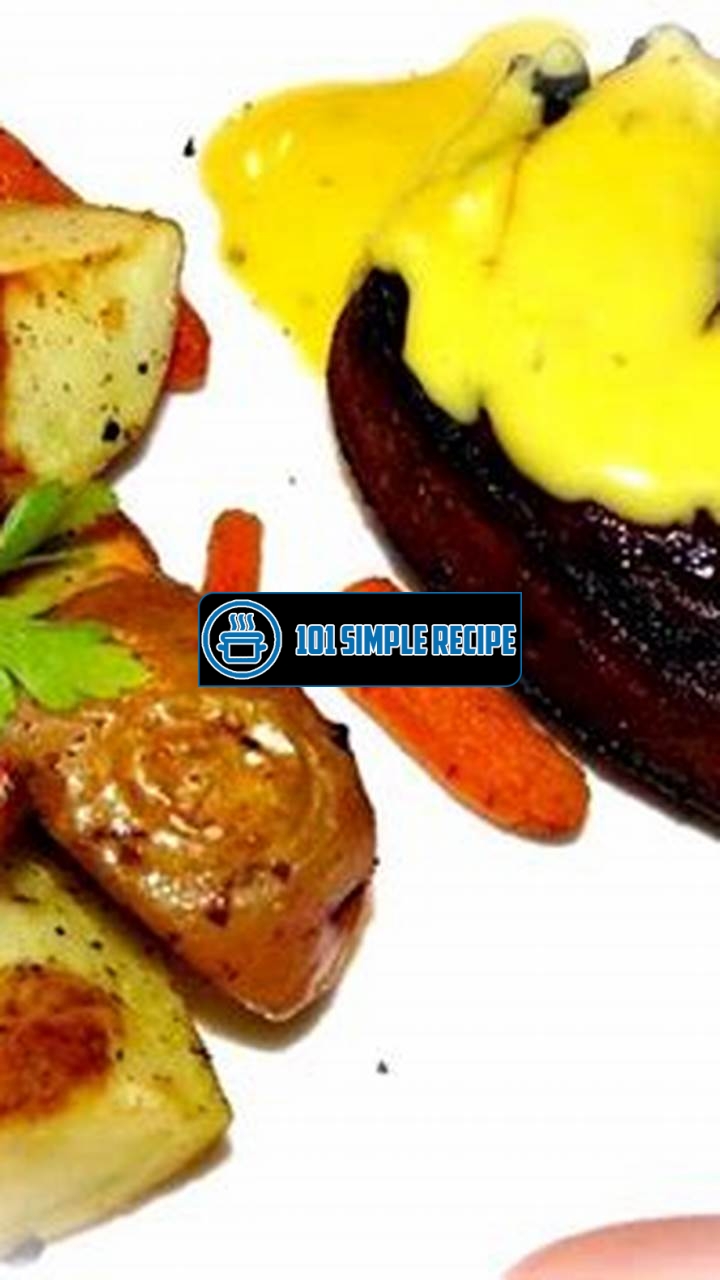Are you craving a delectable and creamy sauce to elevate your favorite dishes? Look no further because Julia Child’s Bearnaise Sauce recipe is the perfect solution! ️ This iconic sauce is renowned for its rich flavor and velvety texture, making it the ultimate accompaniment to steaks, vegetables, and even eggs Benedict. With Julia Child’s unrivaled expertise in French cuisine, you can trust that this recipe will deliver a truly authentic and mouthwatering Bearnaise Sauce every time. So, get ready to impress your taste buds and elevate your cooking game with this remarkable recipe!

Why Julia Child’s Bearnaise Sauce Recipe is a Classic
Julia Child’s Bearnaise sauce recipe is a classic that has withstood the test of time. With its rich flavor and creamy texture, it has become a staple in both French cuisine and international cooking. Let’s explore the history and significance of Julia Child’s famous Bearnaise sauce recipe and discover why it continues to be a favorite among chefs and food enthusiasts.
Julia Child’s Culinary Legacy
Julia Child is renowned for introducing French cuisine to the American public through her television show “The French Chef” and her bestselling cookbook “Mastering the Art of French Cooking.” Her passion for cooking, coupled with her charismatic personality, made her recipes accessible and enjoyable for home cooks.
Fun Fact: Julia Child’s Bearnaise sauce recipe is one of the many French culinary delights she shared with her audience.
The Origins of Bearnaise Sauce
Bearnaise sauce has its origins in French cuisine and is named after the province of Béarn in southwest France. It is believed to be a variation of Hollandaise sauce, another classic French sauce. However, Bearnaise sauce incorporates additional flavors and herbs, giving it a unique taste.
Tip: Bearnaise sauce is often served with grilled meats, roasted vegetables, and eggs Benedict.
The sauce is made by emulsifying egg yolks, butter, vinegar, and a blend of herbs such as tarragon, chervil, and shallots. The result is a velvety smooth sauce with a tangy yet savory flavor profile.
Key Ingredients for Authentic Bearnaise Sauce
Authentic Bearnaise sauce requires a specific set of ingredients to achieve its signature taste and texture. Here are the key elements:
- Egg yolks: The egg yolks work as the base of the sauce and help to emulsify the ingredients.
- Butter: Unsalted butter is melted and slowly incorporated into the egg yolks for richness and a creamy texture.
- Vinegar: Bearnaise sauce traditionally uses tarragon-infused vinegar, which adds acidity and complements the herbaceous flavors.
- Herbs and shallots: A medley of tarragon, chervil, and shallots gives Bearnaise sauce its distinct aroma and taste.
- Salt and pepper: These simple seasonings enhance the overall flavor profile of the sauce.
Pro Tip: To achieve the most authentic flavor, use fresh herbs and high-quality ingredients.
Creating Bearnaise sauce requires technique and precision, as the emulsification process can be delicate. However, Julia Child’s recipe provides detailed instructions and helpful tips to ensure success in the kitchen.
️ So, the next time you want to elevate your culinary skills or impress your guests, consider trying Julia Child’s Bearnaise sauce recipe. Its rich history, delicious taste, and connection to Julia Child’s culinary legacy make it a true classic!
White Castle recipe offers a delicious way to recreate their famous burgers at home.
The Science Behind Bearnaise Sauce
Delve into the chemical reactions and techniques that make Bearnaise sauce a rich and flavorful accompaniment to grilled meats.
The Emulsion Process
In order to understand the science behind Bearnaise sauce, it is important to delve into the emulsion process. Emulsification is the process of combining two immiscible liquids, such as oil and vinegar, into a stable mixture. Bearnaise sauce is a classic example of an emulsion, as it combines melted butter with vinegar and other seasonings.
The emulsion process in Bearnaise sauce happens when the vinegar, seasoned with shallots and tarragon, is slowly blended into the melted butter. This slow and steady blending allows for the vinegar droplets to disperse equally throughout the butter, creating a thick and creamy sauce. The emulsion is stabilized by the presence of egg yolks, which act as emulsifying agents and help to prevent the separation of the oil and vinegar.
Fun fact: The emulsion process in Bearnaise sauce is similar to that of Hollandaise sauce, another classic French sauce.
The Role of Acid in Bearnaise Sauce
Acid plays a crucial role in Bearnaise sauce, as it adds a tangy and bright flavor to the rich and buttery sauce. The primary source of acid in Bearnaise sauce is vinegar, typically white wine vinegar or tarragon vinegar. The acid not only adds flavor but also helps to balance the richness of the butter and egg yolks.
When the acid is added to the melted butter, it helps to neutralize the flavors and create a harmonious balance. The acid also plays a role in the emulsion process, helping to stabilize the mixture and prevent separation. The acidity level can be adjusted according to personal preference, with some recipes calling for a more pronounced tanginess.
Pro tip: If you prefer a stronger acidic flavor, you can increase the amount of vinegar or even experiment with using different types of vinegar for added complexity.
Tips for Achieving the Perfect Consistency
Achieving the perfect consistency for Bearnaise sauce can be a delicate process. Here are some tips to help you achieve a velvety smooth texture:
- Temperature control: It is important to keep a close eye on the temperature when making Bearnaise sauce. Too high heat can cause the butter to separate, resulting in a greasy sauce. Low heat is key to a smooth emulsion.
- Butter consistency: The butter used in Bearnaise sauce should be properly clarified and at room temperature. Clarifying the butter removes impurities, resulting in a cleaner flavor and smoother texture.
- Whisking technique: Whisking is vital in creating and maintaining the emulsion. It is important to whisk constantly and vigorously, ensuring that the vinegar is evenly incorporated into the butter. This helps to create a thick and creamy texture.
Key tip: If the sauce appears too thick, it can be thinned out by adding a small amount of warm water or lemon juice. Conversely, if the sauce is too thin, it can be thickened by gently whisking in a small amount of melted butter.
By understanding the science behind Bearnaise sauce, mastering the emulsion process, appreciating the role of acid, and following these tips for achieving the perfect consistency, you can confidently create a delicious and velvety Bearnaise sauce that will elevate your grilled meats to a whole new level.
Common Mistakes to Avoid When Making Bearnaise Sauce
When attempting to make Bearnaise sauce, there are certain pitfalls and blunders that can easily occur. However, with the right knowledge and techniques, these mistakes can be easily avoided. In this article, we will discuss three common mistakes that are often made when making Bearnaise sauce, and provide helpful tips on how to prevent them.
1. Overheating the Sauce
One of the most common mistakes when making Bearnaise sauce is overheating it. Bearnaise sauce is a delicate emulsion that can easily break if exposed to high temperatures. Overheating can cause the sauce to curdle and separate, resulting in a grainy texture and a less-than-desirable taste. To avoid this mistake, it is important to cook the sauce over low heat and constantly monitor the temperature. If the sauce starts to bubble or simmer, immediately remove it from the heat source and whisk vigorously to cool it down. It is also recommended to use a double boiler or a heat-resistant bowl placed over a saucepan of simmering water to control the temperature more effectively.
Pro Tip: Always remember to keep a close eye on the heat when making Bearnaise sauce to prevent overheating and maintain a smooth, creamy consistency.
2. Insufficient Emulsion Formation
Another common mistake when making Bearnaise sauce is failing to properly form an emulsion. An emulsion is the combination of two immiscible liquids, such as oil and vinegar, into a stable mixture. In the case of Bearnaise sauce, the emulsion is formed by slowly adding melted butter to a mixture of egg yolks and vinegar reduction while whisking vigorously. If the emulsion is not formed correctly, the sauce may turn out thin and watery instead of creamy and thick. To ensure a successful emulsion, it is crucial to add the butter gradually, incorporating it slowly and continuously whisking to create a smooth and homogenous mixture.
Pro Tip: Patience and a steady hand are key when forming the emulsion for Bearnaise sauce. Take your time and add the butter slowly to achieve the desired texture.
3. Proper Handling of Egg Yolks
The final mistake to avoid is improper handling of egg yolks. Bearnaise sauce relies on egg yolks to create its rich and velvety texture. However, if the egg yolks are not handled correctly, they can easily scramble and ruin the sauce. To prevent this from happening, it is essential to temper the egg yolks before adding the melted butter. Tempering involves slowly adding a small amount of the hot butter to the egg yolks while whisking vigorously. This helps to warm up the yolks gradually without cooking them. Once the yolks are tempered, they can safely accept the remaining butter without curdling or scrambling. Remember to whisk constantly and be patient when tempering the yolks to achieve a smooth and luscious Bearnaise sauce.
⚠️ Pro Tip: Always take caution when introducing hot butter to the egg yolks and temper them properly to avoid any unwanted scrambled textures in your Bearnaise sauce.
In conclusion, by avoiding these common mistakes when making Bearnaise sauce, you can ensure a successful and delicious result every time. Remember to watch the heat, create a stable emulsion, and handle the egg yolks with care. With these helpful tips, you’ll be able to enjoy a perfect Bearnaise sauce that would make even Julia Child proud!
Borax ant killer recipe is a helpful solution to get rid of ants in your home.
Variations and Flavor Enhancements for Bearnaise Sauce
Learn how to personalize Julia Child’s Bearnaise sauce recipe by adding different herbs, spices, and other ingredients for unique flavors.
Herb-infused Bearnaise Sauce
One way to add a fresh twist to Julia Child’s classic Bearnaise sauce recipe is to infuse it with herbs. By incorporating herbs like tarragon, chives, or parsley, you can elevate the flavor profile of the sauce and customize it to your liking. The herb-infused Bearnaise sauce not only provides a burst of freshness, but it also adds a delightful aroma to your dish.
To create herb-infused Bearnaise sauce, start by finely chopping your chosen herbs. You can use a single herb or create a blend of multiple herbs for a more complex flavor. Once the herbs are prepared, simply mix them into the sauce during the final stages of cooking. Allow the sauce to simmer for a few minutes to allow the flavors to meld together. The result is a delicious sauce that complements a wide range of dishes, from steak to vegetables.
Spicy Bearnaise Sauce
If you prefer a bit of heat in your Bearnaise sauce, adding some spice is the way to go. By incorporating ingredients like cayenne pepper, red pepper flakes, or even hot sauce, you can transform the classic sauce into a spicy delight. The spicy Bearnaise sauce adds a bold kick to your dishes and can take your culinary creations to the next level.
To create a spicy Bearnaise sauce, start by adding a small amount of your chosen spice to the sauce during the cooking process. Remember to taste as you go and adjust the amount of spice according to your preference. Keep in mind that some spices can become more potent as the sauce simmers, so start with a conservative amount and add more if desired. The result is a tantalizing sauce that adds a fiery kick to your favorite dishes. ️
Sweet and Tangy Bearnaise Sauce
For those who enjoy a touch of sweetness in their savory dishes, a sweet and tangy Bearnaise sauce may be the perfect choice. By incorporating ingredients like honey, Dijon mustard, or a splash of vinegar, you can balance out the richness of the sauce with a hint of sweetness and a tangy punch. The sweet and tangy Bearnaise sauce adds a unique flavor profile to your dishes and can be a delightful surprise for your taste buds.
To create a sweet and tangy Bearnaise sauce, experiment with adding small amounts of honey, Dijon mustard, or vinegar to the sauce. Start with a conservative amount and taste as you go to find the right balance of flavors. The sweetness and tanginess should complement the richness of the sauce without overpowering it. The result is a delectable sauce that adds a delightful twist to your favorite dishes.
By exploring these variations and flavor enhancements, you can transform Julia Child’s Bearnaise sauce recipe into a personalized culinary masterpiece. Whether you prefer the freshness of herbs, the kick of spice, or the sweetness and tanginess of a unique blend, there are endless possibilities to make this classic sauce your own. Get creative in the kitchen and let your taste buds guide you on a flavorful journey. Happy cooking!
Serving Suggestions and Pairings for Bearnaise Sauce
Discover the best ways to serve Bearnaise sauce and the dishes it complements, taking your culinary creations to the next level.
Classic Steak and Bearnaise Sauce
One of the most iconic and mouth-watering combinations is a perfectly cooked steak accompanied by a velvety Bearnaise sauce. Pairing a tender and juicy steak with the rich and tangy flavors of the sauce creates a symphony of tastes that will leave your taste buds singing.
To achieve the ultimate classic steak and Bearnaise sauce experience, start by selecting a high-quality cut of meat. Whether it’s a filet mignon, ribeye, or New York strip, make sure it is well-marbled and thick. Season the steak with salt and pepper, then cook it to your desired level of doneness – whether it’s rare, medium-rare, or well-done.
As the steak rests, prepare the Bearnaise sauce by whisking together egg yolks, tarragon vinegar, and melted butter until the mixture becomes thick and glossy. Season with salt, pepper, and a touch of lemon juice for added brightness. Serve the sauce alongside the steak, allowing diners to drizzle it over their meat to their liking.
For a visual presentation that adds an extra touch of sophistication, garnish the dish with a sprig of fresh tarragon and a sprinkle of finely chopped chives. This classic pairing of steak and Bearnaise sauce is guaranteed to impress your guests and elevate your culinary skills.
Seafood and Bearnaise Sauce
Bearnaise sauce is not only a fantastic accompaniment to meat but also pairs beautifully with seafood. Whether it’s grilled fish, buttery lobster, or tender scallops, the rich flavors of Bearnaise can complement and enhance a variety of seafood dishes.
When serving seafood with Bearnaise sauce, it is important to choose delicate flavors that won’t overpower the sauce. Grilled salmon, for example, has a subtle smokiness that pairs perfectly with the creaminess and herbal notes of the sauce. Lobster tail, on the other hand, with its luscious texture, is elevated to new heights when dipped in a velvety Bearnaise.
Preparing the sauce for seafood is similar to the process for steak. Whisk together egg yolks, white wine vinegar, and melted butter until the sauce thickens. Season with salt, pepper, and a hint of tarragon to complement the seafood flavors. Serve the Bearnaise sauce on the side or drizzle it over the seafood to add richness and depth.
Sprinkle some freshly chopped parsley or chervil on top of the dish to bring a pop of color and freshness. The combination of seafood and Bearnaise sauce is a match made in culinary heaven, showcasing the versatility and exquisite taste of this classic French sauce.
Vegetables, Eggs, and Bearnaise Sauce
Bearnaise sauce is not just reserved for meat and seafood – it can also bring a burst of flavor to vegetable dishes and eggs. Whether you’re serving roasted asparagus, poached eggs, or sautéed mushrooms, the addition of Bearnaise sauce can elevate these humble ingredients into a gourmet sensation.
When pairing Bearnaise sauce with vegetables, opt for those with flavors that can stand up to the richness of the sauce. Asparagus, for example, with its earthy and slightly bitter taste, pairs beautifully with the tanginess and creaminess of Bearnaise. The classic combination of eggs Benedict, featuring poached eggs, Canadian bacon, and an English muffin, is taken to new heights when topped with a luscious Bearnaise sauce.
To prepare the sauce for vegetable and egg dishes, follow the same process as before, whisking together the egg yolks, white wine vinegar, and melted butter. Season with salt, pepper, and a touch of tarragon for added depth. Drizzle the sauce over the vegetables or eggs and watch as they transform into something truly extraordinary.
Consider garnishing the dish with a sprinkle of finely chopped chives or a sprinkle of paprika for an added visual appeal. The combination of vegetables, eggs, and Bearnaise sauce is a wonderful way to introduce the flavors of this classic French sauce to a wider range of dishes.
Coca Cola Cake recipe is a popular dessert that you might enjoy trying.
Frequently Asked Questions
Thank you for taking the time to read our article about the Bearnaise Sauce recipe by Julia Child. We hope you found it informative and engaging. If you have any additional questions or need further assistance, please refer to the FAQs below. Don’t worry, we’ve got you covered!
| No. | Questions | Answers |
|---|---|---|
| 1. | What are the main ingredients needed for Bearnaise Sauce? | The main ingredients for Bearnaise Sauce include egg yolks, white wine vinegar, shallots, tarragon, butter, and salt. These ingredients come together to create a rich and flavorful sauce that complements various dishes. Give it a try! |
| 2. | Is Bearnaise Sauce difficult to make? | While Bearnaise Sauce may seem intimidating at first, it can be mastered with practice. The key is to not rush the process and to follow the recipe instructions carefully. With a little patience, you’ll be able to create a delicious Bearnaise Sauce that will impress your guests. |
| 3. | Can I use dried tarragon instead of fresh? | Although fresh tarragon is preferred for its aromatic flavor, you can use dried tarragon as a substitute. However, be mindful that dried tarragon has a more concentrated flavor, so you may need to adjust the amount used in the recipe. |
| 4. | What dishes can I pair Bearnaise Sauce with? | Bearnaise Sauce is traditionally served with steak, but it can also be enjoyed with other meats, such as roasted chicken or grilled fish. It adds a luxurious touch to any dish and can elevate the flavors to a whole new level. |
| 5. | How long can I store Bearnaise Sauce? | Bearnaise Sauce is best enjoyed fresh, but if you have any leftovers, you can store it in the refrigerator for up to three days. Just make sure to reheat it gently on low heat before serving again. |
| 6. | Can I freeze Bearnaise Sauce? | It is not recommended to freeze Bearnaise Sauce as it may cause the texture to change and the sauce to separate. It’s best to enjoy it fresh or store it in the refrigerator for a few days. |
Thank You for Reading and Visit Again!
We appreciate you taking the time to read our article about the Bearnaise Sauce recipe by Julia Child. We hope you found the information helpful and inspiring. If you have any more culinary inquiries or if there’s a specific recipe you’d like us to cover next, please let us know. Keep exploring and experimenting in the kitchen, and don’t forget to visit again later for more delicious recipes and cooking tips. Happy cooking!
Jump to Recipe
Bearnaise Sauce Recipe by Julia Child

A delightful and creamy Bearnaise Sauce recipe by Julia Child. Perfect for pairing with steak, roasted chicken, or grilled fish. Elevate your dishes with this classic French sauce.
- 3 egg yolks
- 2 tablespoons white wine vinegar
- 2 shallots (minced)
- 1 tablespoon fresh tarragon (chopped)
- 1 cup unsalted butter (melted and clarified)
- Salt (to taste)
- In a small saucepan, combine the white wine vinegar, minced shallots, and fresh tarragon. Bring to a simmer over medium heat and cook until the liquid has reduced by half. Remove from heat and set aside to cool.
- In a heatproof bowl, whisk the egg yolks until thick and pale yellow.
- Place the bowl over a pot of simmering water, creating a double boiler. Whisk the cooled vinegar reduction into the egg yolks.
- Continue whisking the mixture over the gentle heat until it thickens and forms ribbons. Be careful not to overcook or scramble the eggs.
- Remove the bowl from the heat and gradually whisk in the melted and clarified butter, pouring it in a steady stream. The sauce should emulsify and thicken.
- Season with salt to taste and strain the sauce through a fine-mesh sieve to remove any solids.
- Serve the Bearnaise Sauce immediately or keep it warm in a bain-marie until ready to use. Enjoy!






